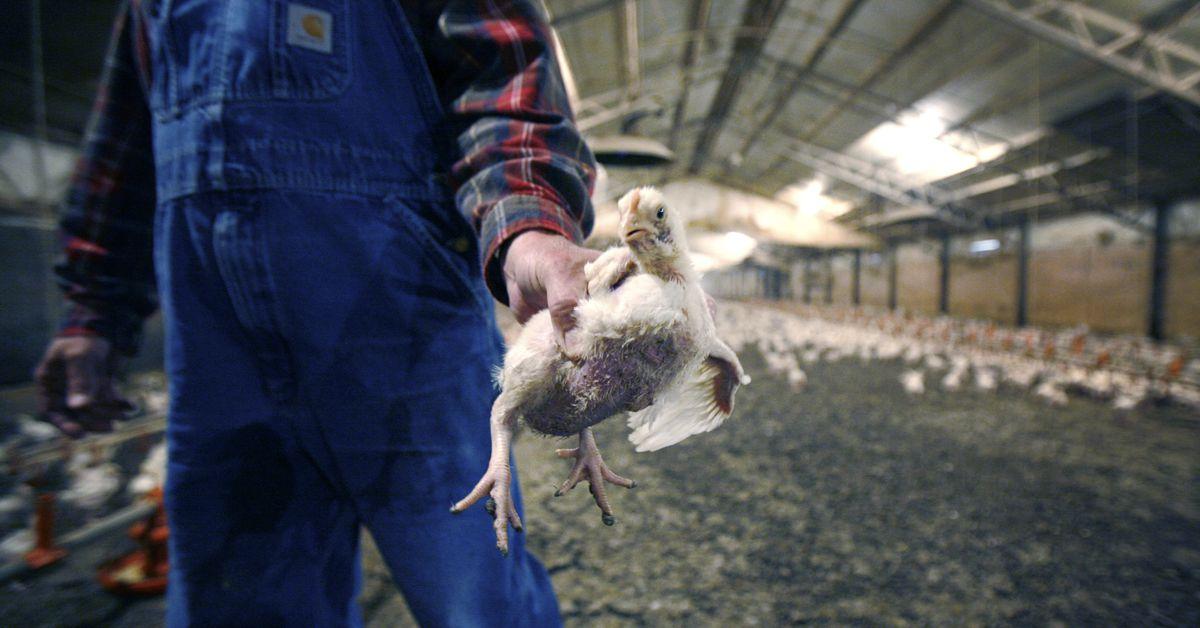
Some archaeologists believe that when future civilizations sort through the debris of our modern era, we won’t be defined by the skyscraper, the iPhone, or the automobile, but rather something humbler: the chicken bone.
The reason? We eat so many chickens. So, so many. In 2020 alone, people around the world consumed over 70 billion of them, up from 8 billion in 1965. Just this Sunday, Americans will likely eat a record-breaking 1.45 billion chicken wings as they watch the Eagles take on the Chiefs at Super Bowl LVII. And that makes it all the more astonishing that, according to chicken industry lore, the system that makes it possible for us to eat so much chicken in the first place originated with a minor clerical error.
The story begins 100 years ago in 1923, with homemaker and farmer Cecile Steele of Ocean View, Delaware. Steele, like many other rural Americans in her time, kept a small flock of chickens that she raised for eggs and waited to slaughter them for meat once their productivity waned. But one day by accident the local chick hatchery delivered 500 birds, 10 times more than the 50 Steele had ordered.
Five hundred hens was a lot — bigger farms at the time had only 300. Returns weren’t really an option in these pre-Amazon days, so she kept them anyway, feeding and watering the chicks by hand in a barn the size of a studio apartment — 256 square feet — that was heated by a coal stove. Four and a half months later, over 100 of the original 500 chicks had died, but she still made a sizable profit off the 2-pound survivors — almost $11 per pound in today’s dollars, adjusted for inflation — and began to ramp up her operations.
Her husband, David “Wilmer” Steele, quit his job in the Coast Guard to help Cecile expand, and within three years, they were raising 10,000 chickens. Word of the Steele family’s success spread, and by 1928 there were hundreds of farmers in the area raising chickens primarily for their meat (before Steele, most farmers raised chickens just for their eggs).
By today’s standards, a 10,000-chicken farm is tiny — a single industrial-style chicken barn will now house upward of 40,000 birds at a time, and farmers usually own several barns apiece. But in Steele’s day, her operation was massive. And the hatchery accident occurred at a fortuitous time — it was the Roaring ’20s, a decade of immense economic growth in the US, which meant Americans had more money in their pockets to eat more meat. Simultaneous advancements in agricultural refrigeration and transportation, along with the rise of chain grocery stores and the expansion of agriculture financing, made that meat more plentiful.
Around this time there were also seemingly small advances around nutrition that had huge implications for mass agriculture. One was the discovery of vitamin D in 1922, according to Emelyn Rude, author of Tastes Like Chicken: A History of America’s Favorite Bird. Chickens would often die of rickets when kept indoors during cold winter months (rickets is caused by a lack of vitamin D, stemming from lack of sunlight). That helped cap the number of chickens that could be raised at any given time, especially in cooler climates. But once farmers began fortifying chicken feed with vitamin D, they could suddenly raise them in larger numbers indoors and year-round.
Not only was Steele’s timing lucky, but so was her location. The Delmarva Peninsula, where Steele’s farm was located, was also the perfect place for large-scale chicken farming to take off. There was cheap, abundant land a relatively short distance from the hungry consumers of Washington, Baltimore, Philadelphia, and New York City.

Steele’s accident set off the chicken revolution as we know it. In the first half of the 20th century, chicken accounted for well under 20 percent of meat consumption in the US. Today, it’s about 44 percent. Over time, chicken benefited from perceptions that it was healthier than red meat, and became cheaper to produce, thus cheaper for consumers. Today grocery stores charge $4 to $10 a pound for beef and pork, while chicken can cost as little as $1.80 a pound. Bacon and steak may take center stage for meat lovers, but when it comes to what’s for dinner, the answer is more often poultry.
Steele didn’t live to see where her experiments ultimately led. With earnings from their burgeoning poultry empire, Steele and her husband — who had become a state senator in 1937 — bought a $10,000 yacht named The Lure. One October day in 1940 they took it out fishing with three guests, and while near Ocean City, Maryland, the carburetor backfired, causing the boat to explode. The others survived, but tragically, Cecile and Wilmer Steele did not.
Through a mix of coincidence and ambition, Steele set off a race to put chicken at the center of the American plate, changing the face of agriculture forever. In the process, we bent the chicken to our will, pushing the species to its biological limits, polluting waterways and our lungs along the way, all to supply a growing population with cheap protein.
The chicken of tomorrow — and today
There’s disagreement over when and where humans first domesticated the spry, tropical, multi-colored red junglefowl of South and Southeast Asia — the ancestor of modern-day chickens — but the latest research estimates it occurred over 3,000 years ago in what is now Thailand. Over the following centuries, humans brought the species through China, India, the Middle East, Northeast Africa, Italy, Britain, and up to Scandinavia, and at some point it was likely cross-bred with India’s gray junglefowl. Chickens have been in the Americas almost as long as Europeans, first stepping foot on what is now the Dominican Republic in 1493, on Christopher Columbus’s second voyage.
As prevalent as chicken is today, archaeologists believe they were first domesticated for cockfighting, not farming — the ancient Greek city of Pergamum even built a cockfighting amphitheater. And even up until the 1940s, chickens played a small role in agriculture compared to beef and pork. That all changed, due to Steele and other pioneers in the 1920s and 1930s, but also sophisticated breeding techniques in the decades that followed, which transformed the chicken from a small egg-layer into a giant, meat-producing machine.
In 1946, two decades after Steele demonstrated how to raise thousands of chickens for meat indoors, a legion of scientists, government employees, meat producers, and volunteers launched a nationwide contest — called The Chicken of Tomorrow — to design a bigger bird. At the time, chickens were bred to lay a lot of eggs, but the grocery chain A&P wanted a chicken that could provide as much meat as possible. And that meant a bird with a big breast.
Out of 40 final contestants, California farmer Charles Vantress came out on top. Vantress cross-bred two varieties — the New Hampshire Red and the Cornish — to create a hybrid bird that, most importantly, converted feed to muscle more efficiently than his competitors (judges scored chickens on 18 criteria in total). For his achievement, Vantress was celebrated with a parade through Georgetown, Delaware — a 40-minute drive from Cecile Steele’s farm — replete with a Festival Broiler Queen (the industry calls chickens raised for meat “broilers”).
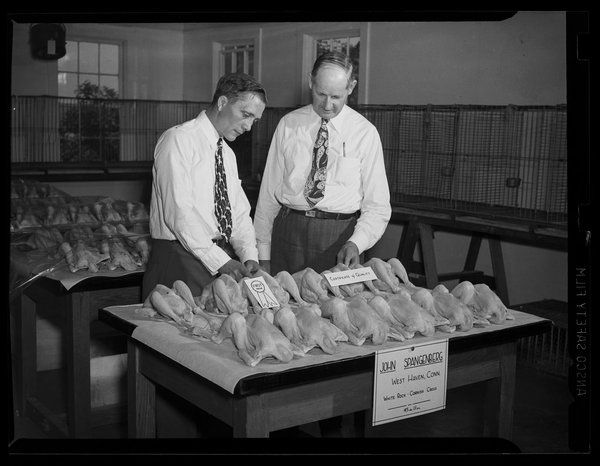
Vantress went on to dominate the field of poultry genetics, eventually selling his breeding lines to chicken giant Tyson Foods in 1974. Twelve years later, Tyson merged his company with a breeding competitor called Cobb to form Cobb-Vantress and by 2016, almost half of the world’s chickens raised for meat were the “Cobb 500” breed.
Around the same time, there was also a leap forward in animal feed. In 1928, Alexander Fleming discovered penicillin, a class of antibiotics that revolutionized modern medicine. Two decades later, American scientists discovered that feeding the antibiotic aureomycin to farmed animals made them grow much faster, a revelation that sparked the rapid adoption of antibiotic use on the farm (one that public health officials, worried about growing antibiotic resistance in humans, have been trying to reverse for decades, with little success).
Human health concerns played a role as well: By the 1970s, public health professionals had increasingly linked consumption of dietary fat to rising rates of heart disease, culminating in a 1977 Senate report — “Dietary Goals for the United States” — that advised Americans to “decrease consumption of animal fat, and choose meats … which will reduce saturated fat intake.”
They recommended chicken, turkey, and fish instead — and for once, Americans listened to experts’ medical advice. Between 1970 and 2019, US beef consumption per person fell 28 percent, while poultry consumption has increased by 173 percent. (Pork consumption per person, despite the industry’s efforts to mimic the success of chicken with the “other white meat” ad campaign, remained largely unchanged over the decades.)
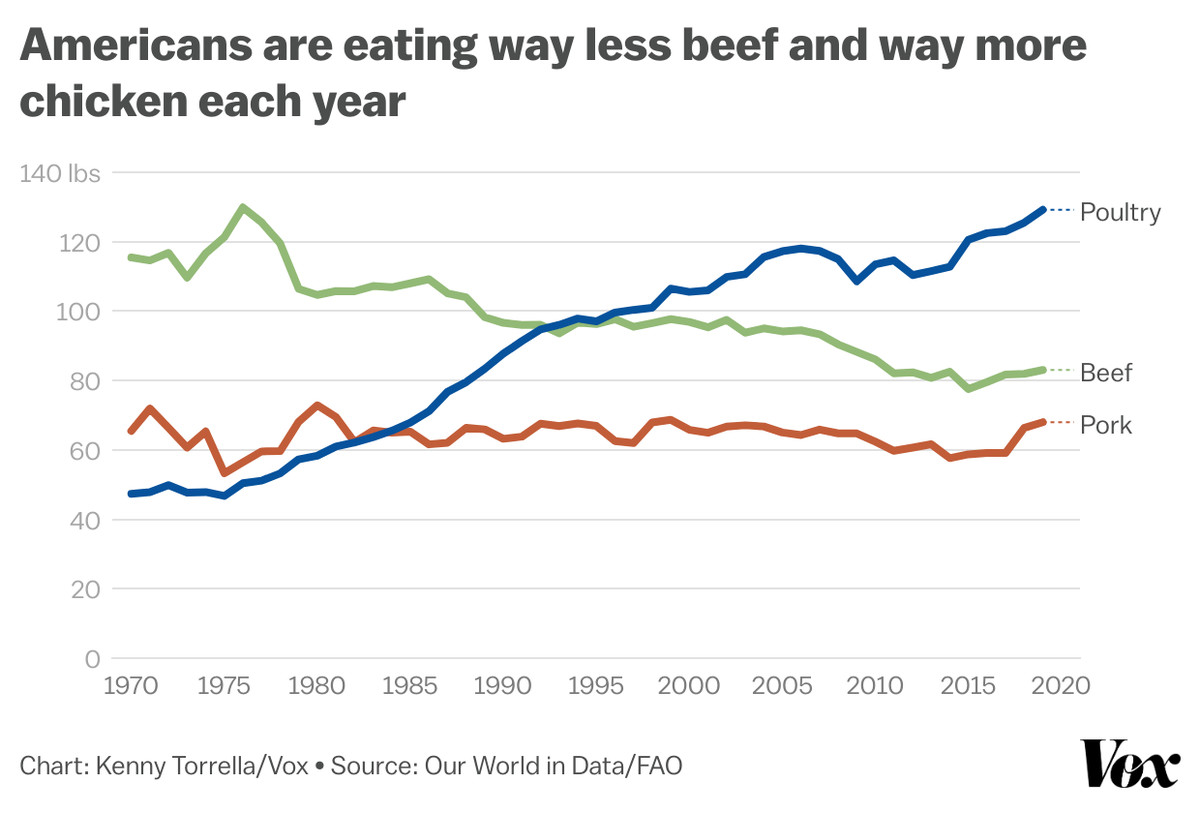
Soon food companies got to work. The chicken nugget was invented in 1963 by an American poultry scientist as a frozen, breaded “chicken stick,” but it wasn’t until the 1983 national launch of the McNugget, which was concocted by a French chef, that it shot into the stratosphere. Stores quickly sold out amid long lines, and 40 years later it’s still a top earner for the company. In 2019, Americans ate an estimated 2.3 billion servings of chicken nuggets.
Chicken has also undergone a cultural makeover. Emelyn Rude, author of Tastes Like Chicken, notes that chicken was long considered feminine, while beef was considered masculine. According to the humorism system of medicine developed by ancient Greek physician Hippocrates, chicken “was mainly just considered a weak and delicate food suitable for weak and delicate people,” Rude said.
But over time, chicken has changed into the meat of choice for bodybuilders and Paleo dieters, due in part to the rise of nutrition science, which classifies foods by their constituent parts — protein, fat, and carbohydrates. “Chicken contained protein, so it was like other meats, but less fat, so it was superior to them, according to dietary guidelines published in the 1980s,” said Rude. “You can still see this sort of idea of red meat and masculinity. … But chicken has definitely made a lot of inroads.”
As much as the chicken has come to be an affordable source of protein, breeding over 9 billion of them for meat in the US each year has proven to be an environmental, labor, and animal welfare catastrophe. We’ve changed them, and in turn, they’ve changed us — and the planet.
What our love for chicken has done to chickens (and us)
If you went inside one of the industrial barns that are home to America’s 9 billion chickens, you’d find most of them sitting down in their own waste. It’s not because they’re lazy, or that they like to hang out in manure. It’s because most of them simply can’t walk.

The Chicken of Tomorrow contests of the 1940s gave way to a new breed of bird so top-heavy that their skinny legs can easily buckle under the weight of their enormous body. Back then, it took 84 days for chickens to reach their “market weight” of three pounds; today, it takes almost half the time to grow more than twice as big.
A now-famous study by Canadian poultry researchers illustrates just how far poultry companies have pushed chickens’ biology. The researchers took breeds from 1957, 1978, and 2005, and fed each bird the same diet for 56 days. At the end of the experiment, the 1957 breed had reached 2 pounds, the 1978 breed reached 4 pounds, and the 2005 breed reached a gigantic 9.2 pounds.

Making chickens grow bigger and faster may be good for the consumer (and the poultry companies), and counterintuitively, today’s rapid-growth model has a smaller carbon footprint than slower-growing, “heritage” breeds. But the rapid-growth model of today is godawful for the chickens, saddling them with a long list of health problems. And as we’ve covered at Vox, the societal shift of replacing beef with chicken means we’re killing far more individual animals for food. Because chickens are so small, you have to kill about 100 of them to get the same amount of meat you would from one cow.
And over the last 50 years, despite a growing US population, the total number of cattle raised and slaughtered for beef each year has actually declined by a few million. Meanwhile, the number of chickens killed annually has increased by 6 billion. Another way to think about it: In 1970, around 16 chickens and one-fifth of a cow were slaughtered for each American. In 2020, it was 23.5 chickens and less than one-tenth of a cow. And while conventionally raised cattle hardly have it great, chickens suffer far more.
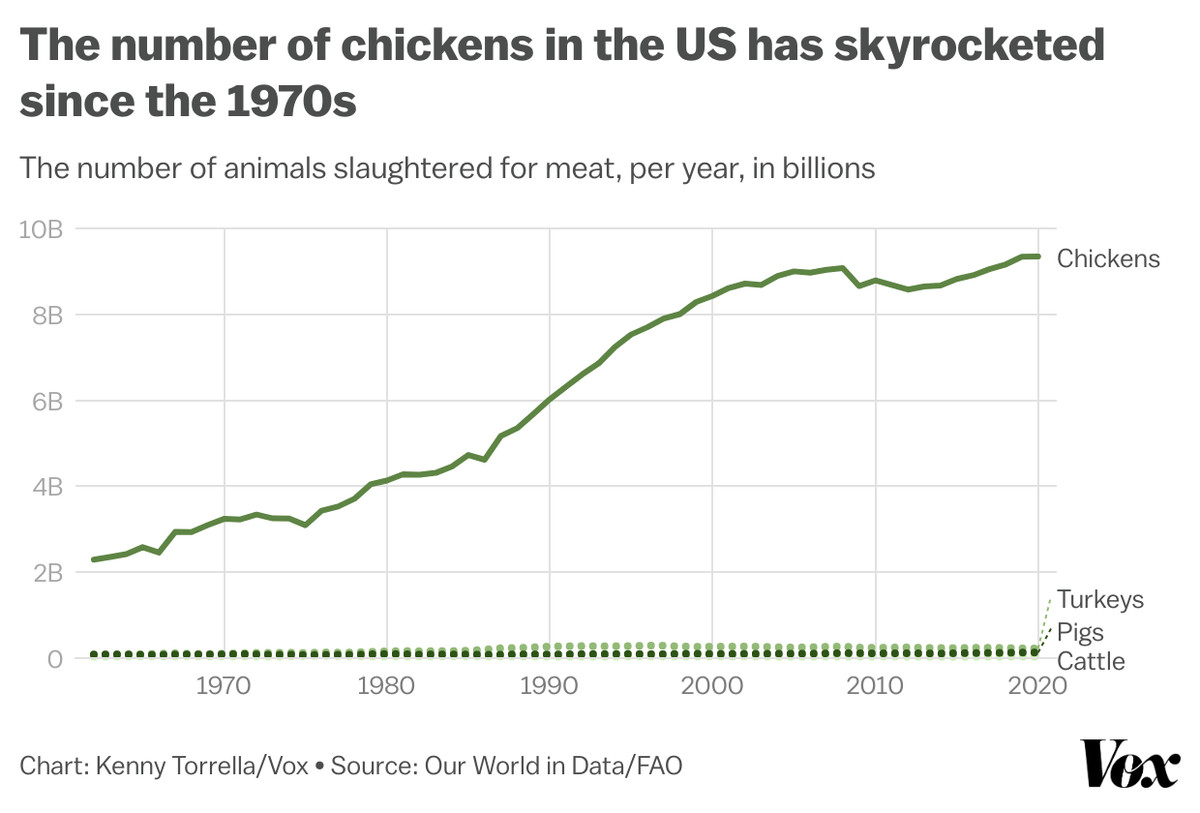
Raising and slaughtering chickens is dangerous, precarious work, too. Most chicken farmers work on contract and take on huge amounts of debt to start their farm; the margins are razor-thin, leaving some to say they feel more like a serf than a farmer, while slaughterhouse work is considered to be one of the most dangerous jobs in America.
Simply living near a chicken farm or slaughter plant can be bad for your health. That much is apparent in Steele’s home state of Delaware which, despite making up less than 0.1 percent of the US land mass, raises 6 percent of the country’s 9 billion birds. Over 500 million are raised in the Delmarva Peninsula alone each year.
Sacoby Wilson, a professor of applied environmental health at the University of Maryland, said pollution from chicken manure comes in many forms: Nitrates can contaminate wells, ammonia can cause respiratory issues, and “poultry dust,” or particulate matter, can cause respiratory and cardiovascular problems. Last year, the Environmental Integrity Project — a nonprofit that advocates for stronger enforcement of environmental laws — found that Delaware and Maryland were the only states where 100 percent of their estuaries were impaired with pollution, in large part due to the high amounts of chicken manure that leaks into streams near farms.
“Chicken waste is hazardous waste,” Sacoby said. “It needs to be treated the same way we treat other major industries.” But animal farms are largely exempted from air and water regulations.
When Cecile Steele took a chance a century ago and raised 500 birds instead of 50, she had no idea of the long chain of events she set off, and she died many years before chicken took over our plates. But she sparked a wholesale transformation of our farming and food systems, our air and water, and the chicken itself — a transformation that made meat more affordable than ever, but with a high cost diffused throughout society and the environment.
It occurred at a time in American history when such costs could hardly be conceived of, a time when people had suffered immense poverty and hunger for years during World War I. But in the 100 years since, we’ve overcorrected, valuing abundance and affordability over public health and environmental sustainability while pushing over 9 billion chickens — and hundreds of thousands of workers and farmers — to their limit.
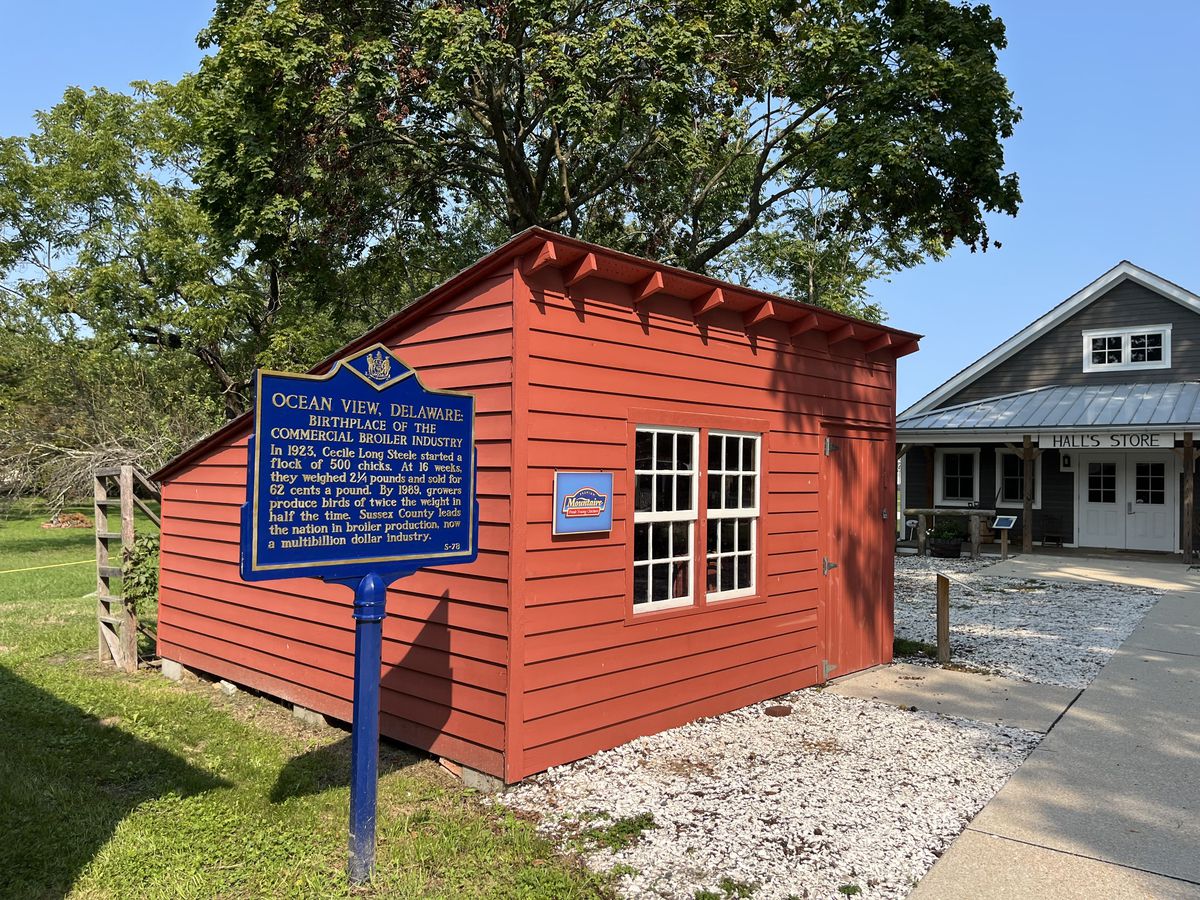
And there’s seemingly no relief in sight. “The problem is we have this food system geared towards incredibly efficient meat production, so it just keeps going and keeps increasing,” Rude said. “There’s no indication that global meat consumption will decline.”
But over this next century, we may witness another overhaul of our food system. Late last year, the US Food and Drug Administration approved the first chicken made directly from animal cells, known as “lab-grown” or cultivated meat. One hundred years from now — if artificial intelligence hasn’t put journalists out of work — a future writer might regale us with the story of the next Cecile Steele. Instead of a farmer, she could be a scientist in a lab somewhere, cooking up the chicken-free chicken of 2123.


